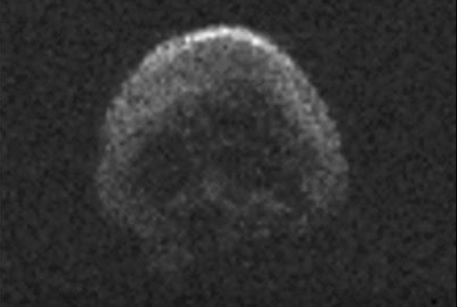
In 2015, NASA announced a skull-shaped asteroid was going to pass Earth at a distance of just 302,000 miles on Halloween that year. The dead comet, 2015 TB145, made headlines across the globe thanks to its eerie appearance. Three years on, the asteroid is now back in the news as it will once again fly by Earth—only this time it will be at a much further distance and no longer really resembles a skull.
Scientists at the University of Hawaii's working on NASA's Near-Earth Object Observations (NEOO) Program first discovered the comet 2015 TB145.
It was initially observed with NASA's Infrared Telescope Facility (IRTF) on Mauna Kea, Hawaii, and the first images came via the National Science Foundation's Arecibo Observatory in Puerto Rico. After analyzing the object, scientists said it was most likely a dead comet that was around 2,000 feet in diameter.
"The IRTF data may indicate that the object might be a dead comet, but in the Arecibo images it appears to have donned a skull costume for its Halloween flyby," Kelly Fast, IRTF program scientist at NASA Headquarters, said in a statement at the time.
Initial predictions suggested 2015 TB145's next visit would be in September 2018, when it would pass by at a distance of around 24 million miles—"about a quarter of the distance between Earth and the Sun," NASA said. This is not considered to be a close encounter. It is now expected to fly past on November 11.

Paul Chodas, manager of NASA's Jet Propulsion Laboratory Center for Near Earth Object Studies, told CNN: "This time it's not coming close enough (to Earth) to be any larger than a dot of light."
According to NASA's Jet Propulsion Laboratory, the next time 2015 TB145 will come anywhere near Earth will be on October 14, 2082, when it will pass at a distance of just over 33 million miles. It will return three years later at the slightly closer distance of 15 million miles, and in 2088 it will make its closest approach, whizzing past us at around 4.6 million miles.
Asteroids and comets—or near Earth objects (NEOS)—often pass by Earth. For example, the object 2014 US7 will pass by on October 17 at a distance of 750,000 miles. NASA searches for and monitors NEOs so that if any of them look like they are going to collide with Earth, they can take steps to minimize risk.
"NASA places a high priority on tracking asteroids and protecting our home planet from them. In fact, the U.S. has the most robust and productive survey and detection program for discovering NEOs, the agency said in a statement. "To date, U.S.-funded assets have discovered over 98 percent of the known NEOs."
Uncommon Knowledge
Newsweek is committed to challenging conventional wisdom and finding connections in the search for common ground.
Newsweek is committed to challenging conventional wisdom and finding connections in the search for common ground.
About the writer
Hannah Osborne is Nesweek's Science Editor, based in London, UK. Hannah joined Newsweek in 2017 from IBTimes UK. She is ... Read more
To read how Newsweek uses AI as a newsroom tool, Click here.








